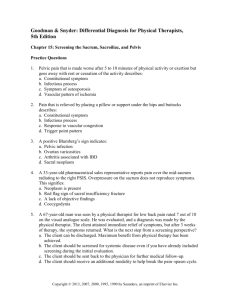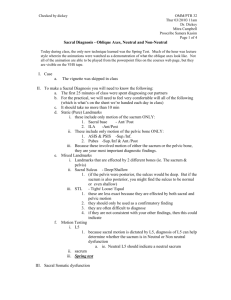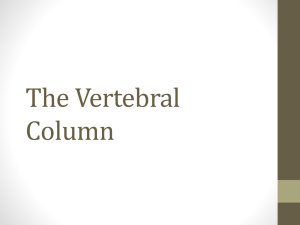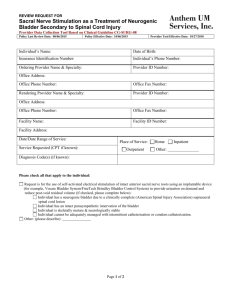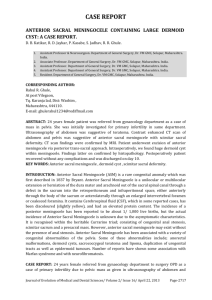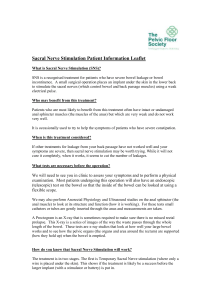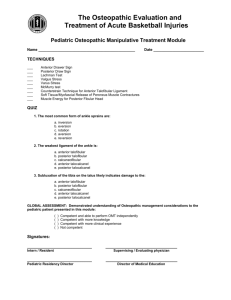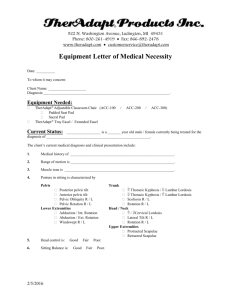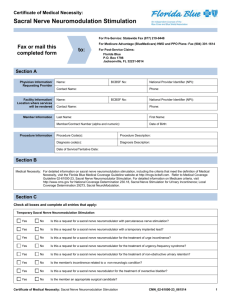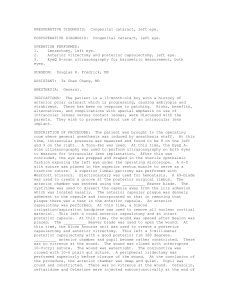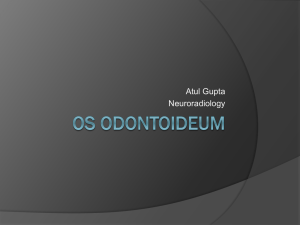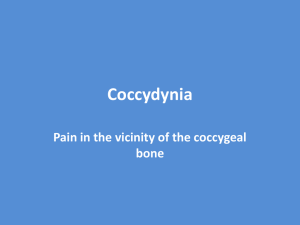I. Sacral Base Anterior (Horizontal axis)
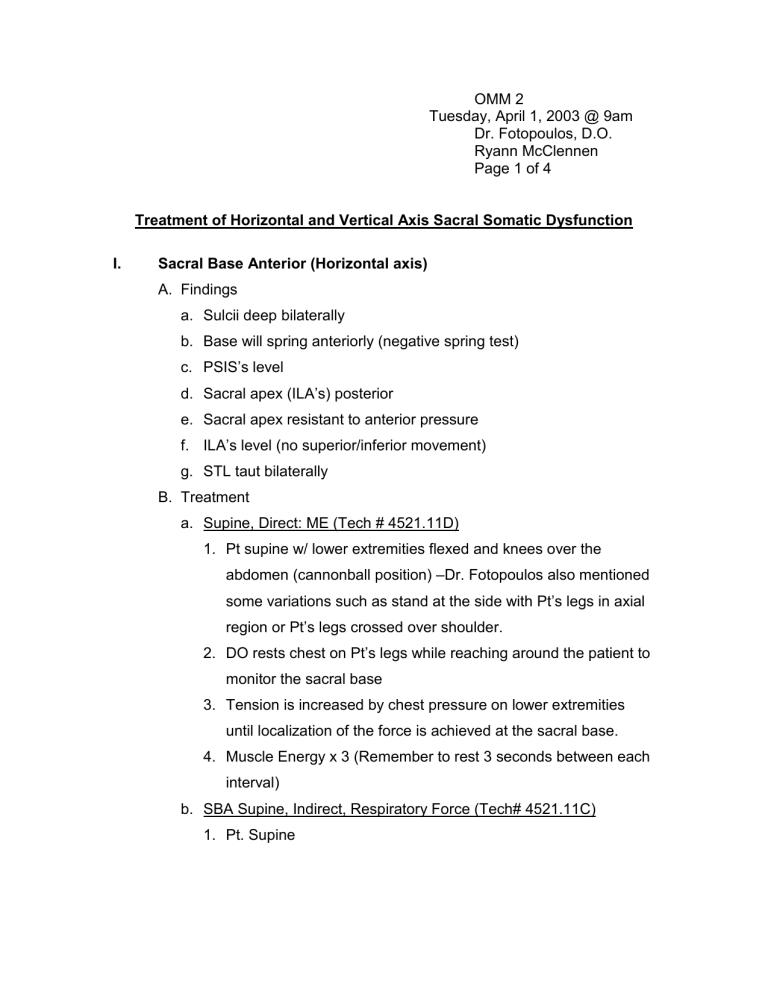
OMM 2
Tuesday, April 1, 2003 @ 9am
Dr. Fotopoulos, D.O.
Ryann McClennen
Page 1 of 4
I.
Treatment of Horizontal and Vertical Axis Sacral Somatic Dysfunction
Sacral Base Anterior (Horizontal axis)
A. Findings a. Sulcii deep bilaterally b. Base will spring anteriorly (negative spring test) c.
PSIS’s level d.
Sacral apex (ILA’s) posterior e. Sacral apex resistant to anterior pressure f. ILA’s level (no superior/inferior movement) g. STL taut bilaterally
B. Treatment a. Supine, Direct: ME (Tech # 4521.11D)
1. Pt supine w/ lower extremities flexed and knees over the abdomen (cannonball position) –Dr. Fotopoulos also mentioned some variations such as stand at the side with Pt’s legs in axial region or Pt’s legs crossed over shoulder.
2. DO rests chest on Pt’s legs while reaching around the patient to monitor the sacral base
3. Tension is increased by chest pressure on lower extremities until localization of the force is achieved at the sacral base.
4. Muscle Energy x 3 (Remember to rest 3 seconds between each interval) b. SBA Supine, Indirect, Respiratory Force (Tech# 4521.11C)
1. Pt. Supine
OMM 2 April 1, 2003
Page 2 of 4
2. DO hand cradles Pt’s Sacrum (To get to sacrum--have patient bend one knee and lift buttocks, slid hand under sacrum, and have patient drop butt and straighten leg).
3. DO applies Anterior tension with finger pads on sacral base
(moving it further anterior —use forearm as a fulcrum)
4. Pt instructed to Exhale completely
5. DO maintains anterior tension until release.
6. Sacral release allows involuntary sacral rocking with respiratory cycle.
II. Sacral Base Posterior (Horizontal axis)
A. Findings a. Sulcii shallow bilaterally b. Base resist springing anteriorly (Positive spring test) c.
PSIS’s level d.
Sacral apex (ILA’s) anterior e. Sacral apex springs further anterior f.
ILA’s level g. STL relaxed
B. Treatment a. SBP Prone, Direct HVLA (Tech # 4522.11A)
1. Pt. Prone on table supporting upper trunk on elbows
2. DO stand at side, place heel of hand on sacral base
3. Lower hand on Pt.’s ankle or leg to stabilize
4. Tension applied to sacral base until barrier reached
5. Pt. Instructed to inhale against tension
6. DO increases contact tension and add HVLA thrust at end of respiratory cycle. b. SBP Supine, Indirect, Respiratory Force (Tech # 4522.11C)
1. Pt supine
OMM 2 April 1, 2003
Page 3 of 4
2. DO hand cradles Pt’s sacrum. (To get to sacrum--have patient bend one knee and lift buttocks, slid hand under sacrum, and have patient drop butt and straighten leg)
3. DO applies Anterior tension with heel of hand on sacral apex (moves sacral bas more posterior – use forearm as a fulcrum)
4. Patient Inhales completely and holds to limit.
5. DO maintains Anterior tension
6. Sacral release allows involuntary sacral rocking with the respiratory cycle.
III. Sacral Margins
A. Findings a. Run the length of the Sacro-Iliac articulation b. They will rotate about a vertical midline or parasagittal axis c. One margin is posterior, the other margin is anterior d. Posterior Margin
1. fullness at both poles and margin (shallow)
–Motion is restricted at poles.
2. ILA is slightly posterior but level in transverse plane
3. STL tight on affected side
4. PSIS’s are level
B. Treatments a. Supine, Direct HVLA (Tech # 4523.11A)
1. Pt. Supine
2. DO on side opposite posterior margin
3. Pull Pt’s hips toward him to edge of table
4. Push feet and torso away to create marked SB concavity on lesioned side with apex at LS jxn in transverse plane
5. Pt. Clasps hands behind neck
OMM 2 April 1, 2003
Page 4 of 4
6. DO reached across pt and inserts cephalad hand and forearm from lateral to medial in space between pt’s arm and forearm and rests dorsum on pt’s chest
7. DO’s caudal hand placed over pt’s ASIS on lesioned side
8. DO straightens cephalad arm and pulls pt toward him, rotating spine into sacrum
9. When rotation is complete and lifting ilium from table, make short quick thrust against ilium into table.
10. Make sure sacrum is still rotating anteriorly. b. SMP Sitting, Direct HVLS or ME (Tech # 4523.11B)
1. Pt seated, straddling table.
2. DO stands behind/off to one side.
3. Pt does Osteopathic Salute to lesioned side.
4.
DO reaches under pt’s arm and across chest to grasp opposite arm.
5.
DO’s other hand monitors lesioned articulation.
6. Pt instructed to sit up straight
7. Rotation is induced w/o Side Bending throughout spine down to sacrum.
8. Muscle energy x 3 or HVLA thrust.
